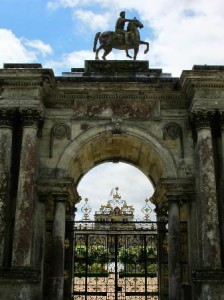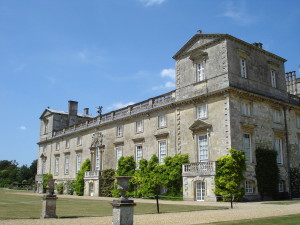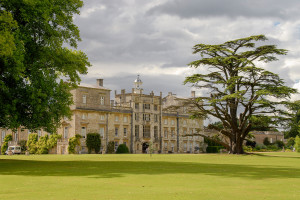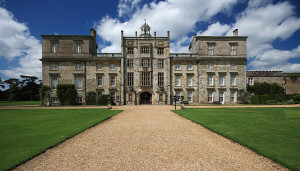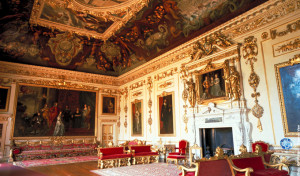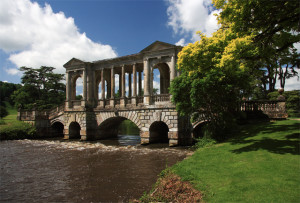I’ve been meaning to write about Wilton House for a while, but was spurred on today when I sold a little brooch in my Etsy shop. I sent a thank-you notecard with the order, one from a set I’d bought many years ago from the Wiltshire Records Office (as was: now the Wiltshire and Swindon History Centre), and the one I chose featured a late 18th century engraving of Wilton House:
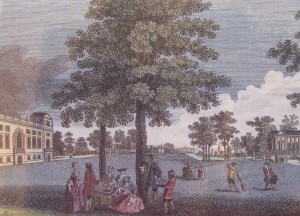
Wilton House. Late 18th century engraving, showing the south front of the house on the left and the Palladian Bridge on the right.
(Or perhaps more accurately, an engraving of a couple of lovely trees and a party of people, with a section of Wilton House and the Palladian Bridge lurking in the background.)
I regularly drive past the impressive gates of Wilton House—so regularly that I’ve almost stopped noticing them. Not an easy feat: just look at them! Isn’t it terrible to take something so spectacular so for granted?
Unlike many of the other grand houses I’ve written about, Wilton House is still a family home, the seat of the Earls of Pembroke for the last 400 years. The first building on the site was a priory founded in c. 871 AD; the first Earl of Pembroke took possession of the site in 1542. Relatively little of the first, Tudor house survives: what is visible today is mostly the Palladian building of the 1630s and 1640s, designed with the involvement of Inigo Jones, and later alterations by James Wyatt in the early 19th century.
The interiors of Wilton House are sumptuous, and among the state rooms designed by Inigo Jones are the Single Cube Room (measuring 30 feet (9.14 m) long, wide and high, and the Double Cube Room, which is 60 feet (18.29 m) long and 30 feet (9.14 m) wide and high.
The grounds and gardens are beautiful, with one of only a handful of Palladian bridges in the country, built over the River Nadder.
Such stunning locations have not surprisingly been used a lot in movie and television filming.
- The Music Lovers, directed by Ken Russell (1970), including scenes filmed in the Double Cube Room.
- Lady Caroline Lamb (1973), partly filmed at Wilton House.
- Romance with a Double Bass (1974), a John Cleese short feature, has scenes filmed in the Double Cube Room.
- Barry Lyndon, directed by Stanley Kubrick (1975), includes scenes set at Castle Hackton, and filmed in the Double Cube Room.
- The Bounty (1984) uses the Double Cube Room to represent the Admiralty building for the court martial of Captain Bligh for the loss of the Bounty.
- The Blackadder II (1986) episode “Bells” features the Palladian bridge and gardens, and the end titles of all episodes from the second series were filmed in the parterre.
- The Madness of King George (1994) features scenes shot in the Double Cube Room: the concert with the bell-ringers, and two later scenes with the Prince of Wales.
- The 1995 film adaptation of Jane Austen’s novel Sense and Sensibility has a London ballroom scene, filmed at Wilton House.
- Mrs Brown (1997) has scenes filmed in the Double Cube Room, again portraying the interior of Windsor Castle.
- The 2005 film adaptation of Jane Austen’s novel Pride and Prejudice has interior scenes set at Pemberley that were filmed at Wilton House (Chatsworth House was used for external shots).
- Beau Brummell: This Charming Man, a 2006 television drama, contained scenes filmed at Wilton House.
- The Young Victoria, a 2009 film about the early years of Queen Victoria’s reign, has scenes filmed at Wilton House.
There is a much more comprehensive list on the Wilton House website location filming page.
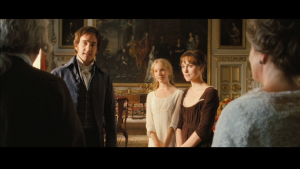
A scene from Pride and Prejudice filmed at Wilton House in the Double Cube Room.
Update 10 August 2015: I’ve just learned that the television series Outlander has just finished two weeks’ filming at Wilton House, which is standing in for the Palace of Versailles. Apparently the British furniture and furnishings were moved out, and appropriate French ones were moved in for the duration of the filming. Plus the candle budget was £1000 a day! Simon Callow was one of the actors.
